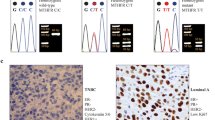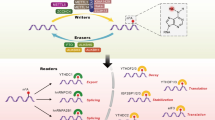Abstract
Our recent study showing association of hyperhomocysteinemia and hypomethioninemia in breast cancer and other studies indicating association of hyperhomocysteinemia with metastasis and development of drug resistance in breast cancer cells treated with homocysteine lead us to hypothesize that homocysteine might modulate the expression of certain tumor suppressors, i.e., RASSF1, RARβ1, CNND1, BRCA1, and p21, and might influence prognostic markers such as BNIP3 by inducing epigenetic alteration. To demonstrate this hypothesis, we have treated MCF-7 and MDA-MB-231 cells with different doses of homocysteine and observed dose-dependent inhibition of BRCA1 and RASSF1, respectively. In breast cancer tissues, we observed the following expression pattern: BNIP3 > BRCA1 > RARβ1 > CCND1 > p21 > RASSF1. Hyperhomocysteinemia was positively associated with BRAC1 hypermethylation both in breast cancer tissue and corresponding peripheral blood. Peripheral blood CpG island methylation of BRCA1 in all types of breast cancer and methylation of RASSF1 in ER/PR-negative breast cancers showed positive correlation with total plasma homocysteine. The methylation of RASSF1 and BRCA1 was associated with breast cancer initiation as well as progression, while BRCA1 methylation was associated with DNA damage. Vitamin B12 showed inverse association with the methylation at both the loci. RFC1 G80A and cSHMT C1420T variants showed positive association with methylation at both the loci. Genetic variants influencing remethylation step were associated positively with BRCA1 methylation and inversely with RASSF1 methylation. GCPII C1561T variant showed inverse association with BRCA1 methylation. We found good correlation of BRAC1 (r = 0.90) and RASSF1 (0.92) methylation pattern between the breast cancer tissue and the corresponding peripheral blood. To conclude, elevated homocysteine influences methionine dependency phenotype of breast cancer cells and is associated with breast cancer progression by epigenetic modulation of RASSF1 and BRCA1 .




Similar content being viewed by others
References
Hoffman, R. M. (1984). Altered methionine metabolism, DNA methylation and oncogene expression in carcinogenesis. A review and synthesis. Biochimica et Biophysica Acta, 738, 49–87.
Halpern, B. C., Clark, B. R., Hardy, D. N., Halpern, R. M., & Smith, R. A. (1974). The effect of replacement of methionine by homocysteine on survival of malignant and normal adult mammalian cells in culture. Proceedings of the National Academy of Sciences of the United States of America, 71, 1133–1136.
Mecham, J. O., Rowitch, D., Wallace, C. D., Stern, P. H., & Hoffman, R. M. (1983). The metabolic defect of methionine dependence occurs frequently in human tumor cell lines. Biochemical and Biophysical Research Communications, 117, 429–434.
Judde, J. G., Ellis, M., & Frost, P. (1989). Biochemical analysis of the role of transmethylation in the methionine dependence of tumor cells. Cancer Research, 49(17), 4859–4865.
Zhang, W., Braun, A., Bauman, Z., Olteanu, H., Madzelan, P., & Banerjee, R. (2005). Expression profiling of homocysteine junction enzymes in the NCI60 panel of human cancer cell lines. Cancer Research, 65(4), 1554–1560.
Carson, D. A., Willis, E. H., & Kamatani, N. (1983). Metabolism to methionine and growth stimulation by 5′-methylthioadenosine and 5′-methylthioinosine in mammalian cells. Biochemical and Biophysical Research Communications, 112, 391–397.
Crott, J., Thomas, P., & Fenech, M. (2001). Normal human lymphocytes exhibit a wide range of methionine-dependency which is related to altered cell division but not micronucleus frequency. Mutagenesis, 16, 317–322.
Hall, C. A., Begley, J. A., & Chu, R. C. (1986). Methionine dependency of cultured human lymphocytes. Proceedings of the Society for Experimental Biology and Medicine, 182, 215–220.
James, S. J., Yin, L., & Swendseid, M. E. (1989). DNA strand break accumulation, thymidylate synthesis and NAD levels in lymphocytes from methyl donor-deficient rats. Journal of Nutrition, 119, 661–664.
Beetstra, S., Suthers, G., Dhillon, V., Salisbury, C., Turner, J., Altree, M., et al. (2008). Methionine-dependence phenotype in the one-carbon metabolic pathway in BRCA1 and BRCA2 mutation carriers with and without breast cancer. Cancer Epidemiology, Biomarkers & Prevention, 17(10), 2565–2571.
Naushad, S. M., Pavani, A., Digumarti, R. R., Gottumukkala, S. R., & Kutala, V. K. (2011). Epistatic interactions between loci of one-carbon metabolism modulate susceptibility to breast cancer. Molecular Biology Reports, 38(8), 4893–4901.
Gatt, A., Makris, A., Cladd, H., Burcombe, R. J., Smith, J. M., Cooper, P., et al. (2007). Hyperhomocysteinemia in women with advanced breast cancer. International Journal of Laboratory Hematology, 29(6), 421–425.
Ryu, C. S., Kwak, H. C., Lee, K. S., Kang, K. W., Oh, S. J., Lee, K. H., et al. (2011). Sulfur amino acid metabolism in doxorubicin-resistant breast cancer cells. Toxicology and Applied Pharmacology, 255(1), 94–102.
Evron, E., Dooley, W. C., Umbricht, C. B., Rosenthal, D., Sacchi, N., Gabrielson, E., et al. (2001). Detection of breast cancer cells in ductal lavage fluid by methylation-specific PCR. Lancet, 357, 1335–1336.
Fackler, M. J., McVeigh, M., Mehrotra, J., Blum, M. A., Lange, J., Lapides, A., et al. (2004). Quantitative multiplex methylation-specific PCR assay for the detection of promoter hypermethylation in multiple genes in breast cancer. Cancer Research, 64, 4442–4452.
Fackler, M. J., Malone, K., Zhang, Z., Schilling, E., Garrett-Mayer, E., Swift-Scanlan, T., et al. (2006). Quantitative multiplex methylation-specific PCR analysis doubles detection of tumor cells in breast ductal fluid. Clinical Cancer Research, 12, 3306–3310.
Müller, H. M., Widschwendter, A., Fiegl, H., Ivarsson, L., Goebel, G., Perkmann, E., et al. (2003). DNA methylation in serum of breast cancer patients: An independent prognostic marker. Cancer Research, 63, 7641–7645.
Mangia, A., Tommasi, S., Bruno, M., Malfettone, A., D’Amico, C., Zito, F. A., et al. (2010). Histological features of extratumoral breast lesions as a predictive factor of familial breast cancer. Oncology Reports, 23(6), 1641–1645.
Han, S. H., Lee, K. R., Lee, D. G., Kim, B. Y., Lee, K. E., & Chung, W. S. (2006). Mutation analysis of BRCA1 and BRCA2 from 793 Korean patients with sporadic breast cancer. Clinical Genetics, 70(6), 496–501.
Mohammad, N. S., Yedluri, R., Addepalli, P., Gottumukkala, S. R., Digumarti, R. R., & Kutala, V. K. (2011). Aberrations in one-carbon metabolism induce oxidative DNA damage in sporadic breast cancer. Molecular and Cellular Biochemistry, 349(1–2), 159–167.
Tan, E. Y., Campo, L., Han, C., Turley, H., Pezzella, F., Gatter, K., et al. (2007). BNIP3 as a progression marker in primary human breast cancer; opposing functions in in situ versus invasive cancer. Clinical Cancer Research, 13(2 Pt 1), 467–474.
Holstege, H., Horlings, H. M., Velds, A., Langerød, A., Børresen-Dale, A. L., van de Vijver, M. J., et al. (2010). BRCA1-mutated and basal-like breast cancers have similar aCGH profiles and a high incidence of protein truncating TP53 mutations. BMC Cancer, 10, 654.
Tischkowitz, M. D., & Foulkes, W. D. (2006). The basal phenotype of BRCA1-related breast cancer: past, present and future. Cell Cycle, 5(9), 963–967.
Lee, J. S., Fackler, M. J., Lee, J. H., Choi, C., Park, M. H., Yoon, J. H., et al. (2010). Basal-like breast cancer displays distinct patterns of promoter methylation. Cancer Biology & Therapy, 9(12), 1017–1024.
Naushad, S. M., Pavani, A., Rupasree, Y., Divyya, S., Deepti, S., Digumarti, R. R., Gottumukkala, S. R., Prayaga, A., Kutala, V. K. (2011). Aberration in one-carbon metabolism influence molecular phenotype and grade of breast cancer. Molecular Carcinogenesis. doi:10.1002/mc.21830.
Joosse, S. A., Brandwijk, K. I., Mulder, L., Wesseling, J., Hannemann, J., & Nederlof, P. M. (2011). Genomic signature of BRCA1 deficiency in sporadic basal-like breast tumors. Genes, Chromosomes and Cancer, 50(2), 71–81.
Wei, M., Xu, J., Dignam, J., Nanda, R., Sveen, L., Fackenthal, J., et al. (2008). Estrogen receptor alpha, BRCA1, and FANCF promoter methylation occur in distinct subsets of sporadic breast cancers. Breast Cancer Research and Treatment, 111(1), 113–120.
Pepe, C., Guidugli, L., Sensi, E., Aretini, P., D’Andrea, E., Montagna, M., et al. (2007). Methyl group metabolism gene polymorphisms as modifier of breast cancer risk in Italian BRCA1/2 carriers. Breast Cancer Research and Treatment, 103(1), 29–36.
Burbee, D. G., Forgacs, E., Zöchbauer-Müller, S., Shivakumar, L., Fong, K., Gao, B., et al. (2001). Epigenetic inactivation of RASSF1A in lung and breast cancers and malignant phenotype suppression. Journal of the National Cancer Institute, 93, 691–699.
Karray-Chouayekh, S., Trifa, F., Khabir, A., Boujelbane, N., Sellami-Boudawara, T., Daoud, J., et al. (2010). Aberrant methylation of RASSF1A is associated with poor survival in Tunisian breast cancer patients. Journal of Cancer Research and Clinical Oncology, 136(2), 203–210.
Pirouzpanah, S., Taleban, F. A., Atri, M., Abadi, A. R., & Mehdipour, P. (2010). The effect of modifiable potentials on hypermethylation status of retinoic acid receptor-beta2 and estrogen receptor-alpha genes in primary breast cancer. Cancer Causes and Control, 21(12), 2101–2111.
Cho, Y. H., Yazici, H., Wu, H. C., Terry, M. B., Gonzalez, K., Qu, M., et al. (2010). Aberrant promoter hypermethylation and genomic hypomethylation in tumor, adjacent normal tissues and blood from breast cancer patients. Anticancer Research, 30(7), 2489–2496.
Naushad, S. M., Prayaga, A., Digumarti, R. R., Gottumukkala, S. R., Kutala, V. K. (2011). Bcl-2/adenovirus E1B 19 kDa-interacting protein 3 (BNIP3) expression is epigenetically regulated by one-carbon metabolism in invasive duct cell carcinoma of breast. Molecular and Cellular Biochemistry, 361(1–2), 189–195.
Xue, W. J., Li, C., Zhou, X. J., Guan, H. G., Qin, L., Li, P., et al. (2008). RASSF1A expression inhibits the growth of hepatocellular carcinoma from Qidong County. Journal of Gastroenterology and Hepatology, 23(9), 1448–1458.
Naushad, S. M., Reddy, C. A., Rupasree, Y., Pavani, A., Digumarti, R. R., Gottumukkala, S. R., Kuppusamy, P., Kutala, V. K. (2011). Cross-talk between one-carbon metabolism and xenobiotic metabolism: implications on oxidative DNA damage and susceptibility to breast cancer. Cell Biochemistry and Biophysics, 61(3), 715–723.
Mirza, S., Sharma, G., Prasad, C. P., Parshad, R., Srivastava, A., Gupta, S. D., et al. (2007). Promoter hypermethylation of TMS1, BRCA1, ERalpha and PRB in serum and tumor DNA of invasive ductal breast carcinoma patients. Life Sciences, 81, 280–287.
Moscow, J. A., Gong, M., He, R., Sgagias, M. K., Dixon, K. H., Anzick, S. L., et al. (1995). Isolation of a gene encoding a human reduced folate carrier (RFC1) and analysis of its expression in transport-deficient, methotrexate-resistant human breast cancer cells. Cancer Research, 55(17), 3790–3794.
Kokkinakis, D. M., Liu, X., & Neuner, R. D. (2005). Modulation of cell cycle and gene expression in pancreatic tumor cell lines by methionine deprivation (methionine stress): Implications to the therapy of pancreatic adenocarcinoma. Molecular Cancer Therapeutics, 4(9), 1338–1348.
Worm, J., Kirkin, A. F., Dzhandzhugazyan, K. N., & Guldberg, P. (2001). Methylation-dependent silencing of the reduced folate carrier gene in inherently methotrexate-resistant human breast cancer cells. Journal of Biological Chemistry, 276(43), 39990–40000.
Cho, Y. H., Yazici, H., Wu, H. C., Terry, M. B., Gonzalez, K., Qu, M., et al. (2010). Aberrant promoter hypermethylation and genomic hypomethylation in tumor, adjacent normal tissues and blood from breast cancer patients. Anticancer Research, 30(7), 2489–2496.
Widschwendter, M., Apostolidou, S., Raum, E., Rothenbacher, D., Fiegl, H., Menon, U., et al. (2008). Epigenotyping in peripheral blood cell DNA and breast cancer risk: A proof of principle study. PLoS ONE, 3(7), e2656.
Radpour, R., Barekati, Z., Kohler, C., Lv, Q., Bürki, N., Diesch, C., et al. (2011). Hypermethylation of tumor suppressor genes involved in critical regulatory pathways for developing a blood-based test in breast cancer. PLoS ONE, 6(1), e16080.
Acknowledgments
This work was supported by the grant funded by Indian Council of Medical Research (ICMR), New Delhi (Ref No. 5/13/32/2007), and Department of Biotechnology (BT/PR9637/BRB/10/582/2007). VKK and SGK are recipients of Ramanujan Fellowship awarded by Department of Science and Technology, Government of India. SD is recipient of Lady Tata Junior Research Fellowship.
Author information
Authors and Affiliations
Corresponding author
Rights and permissions
About this article
Cite this article
Naushad, S.M., Reddy, C.A., Kumaraswami, K. et al. Impact of Hyperhomocysteinemia on Breast Cancer Initiation and Progression: Epigenetic Perspective. Cell Biochem Biophys 68, 397–406 (2014). https://doi.org/10.1007/s12013-013-9720-7
Published:
Issue Date:
DOI: https://doi.org/10.1007/s12013-013-9720-7




